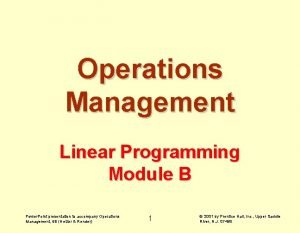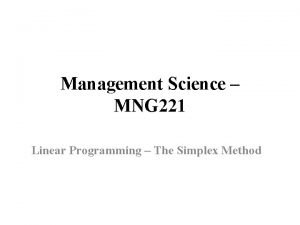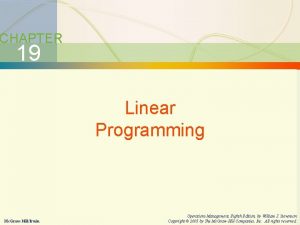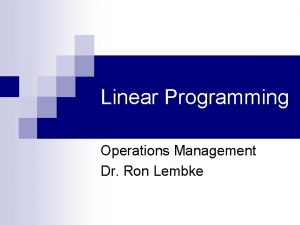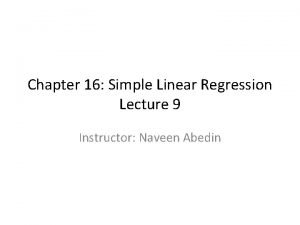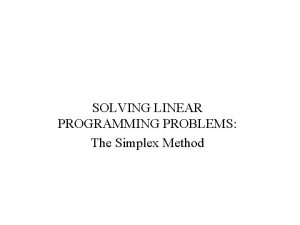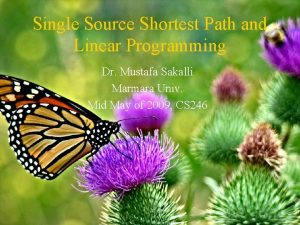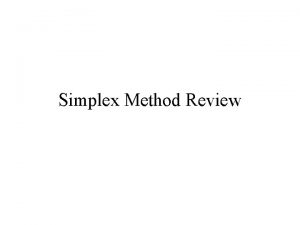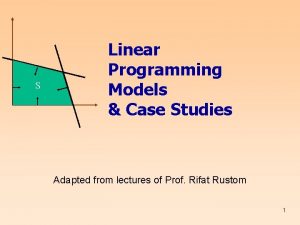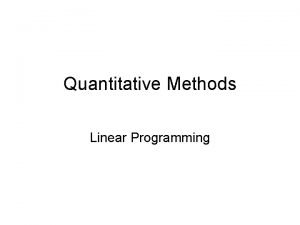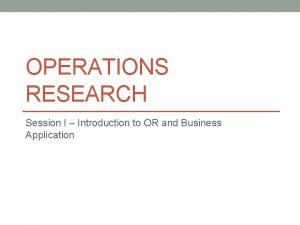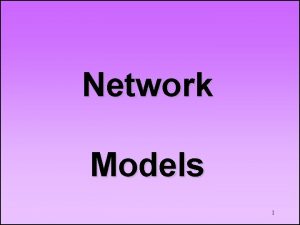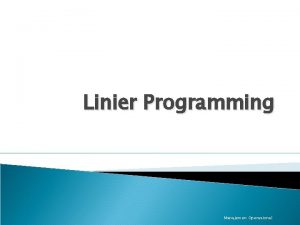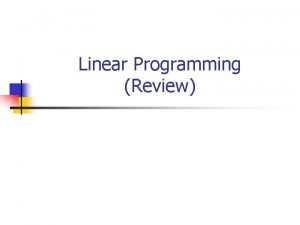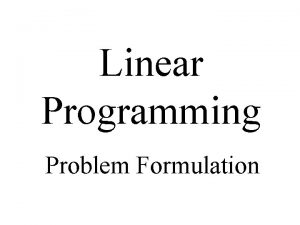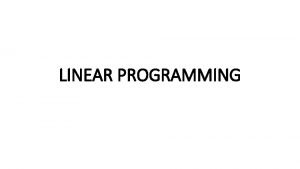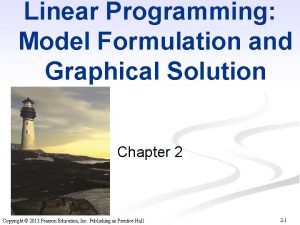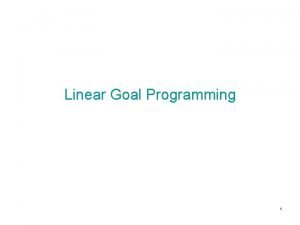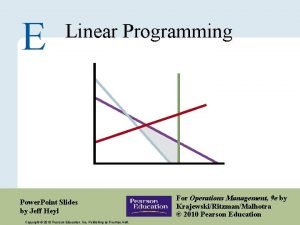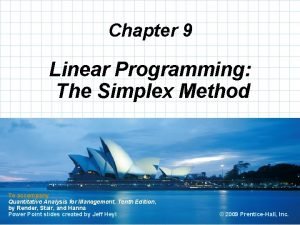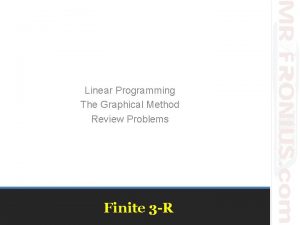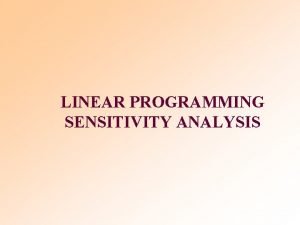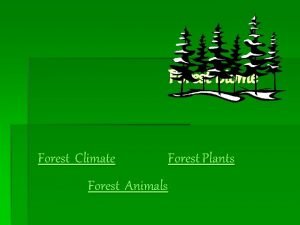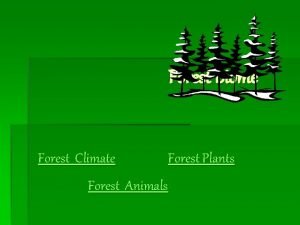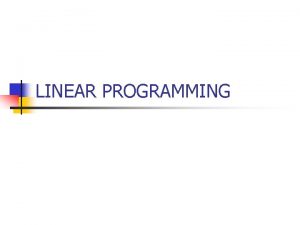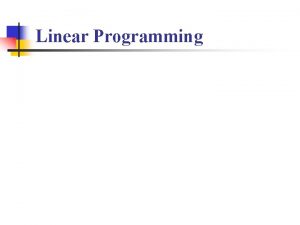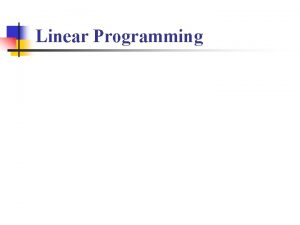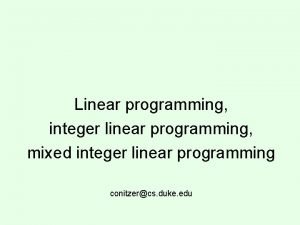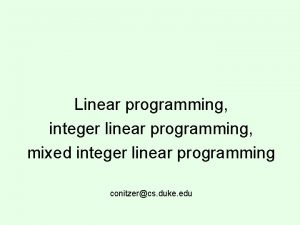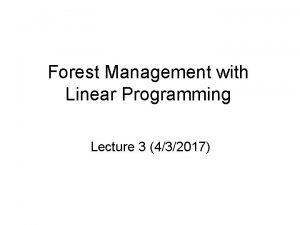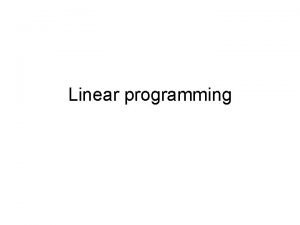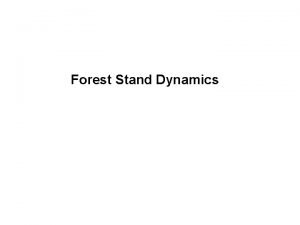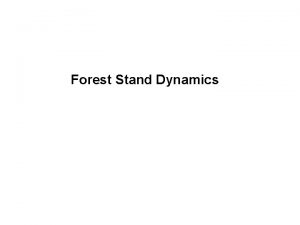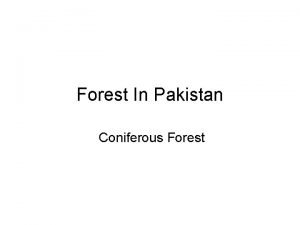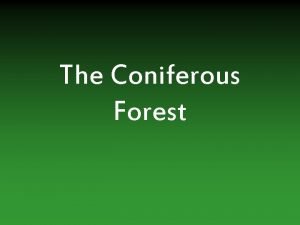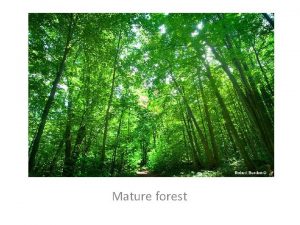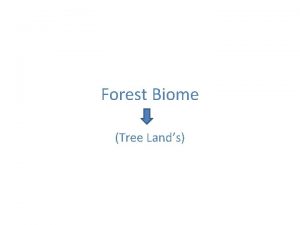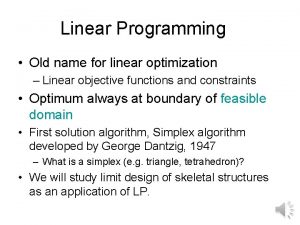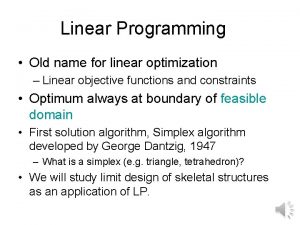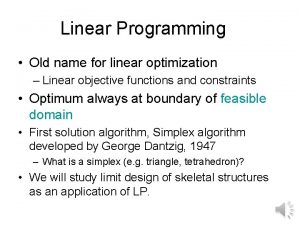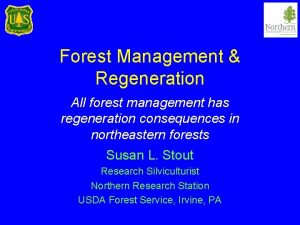Forest Management with Linear Programming Lecture 4 4112016
































- Slides: 32

Forest Management with Linear Programming Lecture 4 (4/11/2016)

What is forest management? • “Identifying and selecting management alternatives forested areas, large and small, to best meet landowner objectives within the constraints of the law and the ethical obligations of the landowner to be a responsible steward of the land. ” (Mc. Dill’s Fores Resource Management)

Key points of the definition • Forest Management must be driven by landowner objectives; • Resource professionals can only determine how these objectives are best met, but they cannot define the objectives themselves; • What is best for the forest? vs. What is best for the people? • Landowners have property rights as well as moral/ethical obligations to be good stewards.

Balancing the Age-class Distribution

The regulated forest • Regulated forest: a forest with an equal number of acres in each age class • Forest regulation: the process of converting a forest with an unbalanced age-class distribution into a regulated forest • The purpose of forest regulation is to achieve a state where an even flow of products can be produced in perpetuity

The regulated forest cont. • A regulated forest provides sustainability and stability • In a regulated forest, the oldest age class is harvested each year, the age-class distribution is maintained

Planning periods and the planning horizon 10 -yr planning period 1 2 3 4 5 6 7 8 9 10 A 100 -yr planning horizon (the conversion interval) Unregulated forest Regulated forest Period length Rotation age Area in each age class

Methods of Forest Regulation • How to get from existing forest with an unbalanced age-class distribution to a regulated forest? • The area and volume control focus on cutting a target area (or volume) in each period • Linear Programming

Developing a harvest scheduling model: an example Initial age-class distribution Age Classes Acres by site class Yield Harvest Age Volume (cds) by site class Site II 10 2 5 4, 000 20 10 14 9, 000 7, 000 30 20 27 18, 000 19, 000 40 31 38 50 37 47 60 42 54 70 46 60 Site II 0 -10 3, 000 8, 000 11 -20 6, 000 21 -30 Total Analysis area If the acres that are initially in age-class 0 -10 are to be cut in period 2, they will be 5+15=20 yrs old at the time of harvest.

Economic Data Economic data LEV Symbol Amount Wood Price P Planting Cost E Item LEV $25/cd Harvest Age Site II $100. 00/ac 20 $11. 66 $94. 94 30 $69. 83 $147. 21 40 $72. 01 $117. 68 50 $31. 43 $72. 04 60 -$2. 66 $28. 60 R*(yr) 40 30 Timber Sales Cost -per acre -per cord sf sv $15. 00/ac $0. 20/cd Interest Rate r 4%

Formulating the example problem as a cost minimization LP 1. Define variables

2. Formulating the objective-function Where csap= the present value of the cost of assigning one acre to the variable Xsap.

• Calculating csap: Note: If p=0 then csap=0

Calculating the harvest ages and volumes Harvest Age Volume – Site I Initial Age Class Volume – Site II Harvest period Period 1 Period 2 Period 3 0 -10 10 20 30 v 111=2 v 112=10 v 113=20 v 211=5 v 212=14 v 213=27 11 -20 20 30 40 v 121=10 v 122=20 v 123=31 v 221=14 v 222=27 v 223=38 21 -30 30 40 50 v 131=20 v 132=31 v 133=37 v 231=27 v 232=38 v 233=47

3. Formulating the constraints a) Area constraints (for each analysis area): you cannot manage more acres than what you have

b) Harvest target constraints: Require the production of some minimum timber output in each period The harvest target for the first decade with Hundeshagen’s formula: The harvest target for the second decade: (H 1+LTSY)/2=295, 000 cd/period The harvest target constraint for period 1: The specific harvest target constraints for periods 1 -2:

b) Ending age constraints: One way to ensure that the forest that is left standing at the end of the planning horizon will be of a desirable condition Several alternative constraints exist: i. Target ending age-class distribution ii. Target ending inventory iii. Average ending age constraints Calculating the average of a forest (example): Age Class Avg. Age Acres 0 -10 5 300 11 -20 15 100 21 -30 25 250

Ending age constraints cont. Where: = the average of the forest in year 30.

Ending age constraints cont. This leads to the general form of the constraint: Where = the target minimum average of the forest in year 30

Ending age constraints cont. Calculating the Initial Age Class coefficients: Site II Harvest Period Not Cut Period 1 Period 2 Period 3 Not Cut Period 1 0 -10 11 -20 21 -30 How should we set the minimum average ending age: What is the average of the regulated forest? (R*+1)/2 Site I: (40+1)/2= 20. 5 Site II: (30+1)/2=15. 5 Average for the two sites: 17. 93 yrs Period 2 Period 3

Ending age constraints cont. Non-negativity Constraints

Harvest Scheduling with Profit Maximization • No harvest targets are necessary • More flexibility • One can let the model tell how much to harvest • Disadvantage: the price of wood must be projected for the duration of the planning horizon

The objective function:

Example:

Constraints • Area constraints (same as in the cost minimization problem):

Constraint cont. • Harvest fluctuation constraints: limit the amount the harvest can go up or down from one period to the next and ensures an even flow of timber from the forest The harvest target constraint from cost minimization: The harvest accounting constraint for profit maximization:

Constraints cont. • Harvest fluctuation constraints cont.

Constraints cont. • Average ending age constraints (same as in cost minimization):

Constraints cont. • Non-negativity constraints:



 Perbedaan linear programming dan integer programming
Perbedaan linear programming dan integer programming Linear vs integer programming
Linear vs integer programming Definisi linear
Definisi linear 01:640:244 lecture notes - lecture 15: plat, idah, farad
01:640:244 lecture notes - lecture 15: plat, idah, farad What is linear programming in management science
What is linear programming in management science Linear programming in operations management
Linear programming in operations management How to calculate zj in simplex method
How to calculate zj in simplex method Operations management linear programming
Operations management linear programming Operations management linear programming
Operations management linear programming C data types with examples
C data types with examples Linear regression lecture
Linear regression lecture Greedy algorithm vs dynamic programming
Greedy algorithm vs dynamic programming System programming vs application programming
System programming vs application programming Linear programming problems and solutions doc
Linear programming problems and solutions doc Shortest path problem linear programming
Shortest path problem linear programming Canonical form linear programming
Canonical form linear programming Linear programming case study
Linear programming case study Non negativity constraints
Non negativity constraints Scope of linear programming
Scope of linear programming Network model linear programming
Network model linear programming Linear management
Linear management Linear programming word problems
Linear programming word problems Linear programming characteristics
Linear programming characteristics An animal feed company must produce
An animal feed company must produce Pengertian linear
Pengertian linear Linear programming model formulation and graphical solution
Linear programming model formulation and graphical solution Linear vs integer programming
Linear vs integer programming Scope of linear programming
Scope of linear programming Goal programming
Goal programming Linear programming powerpoint
Linear programming powerpoint What cj-zj represents
What cj-zj represents Linear programming graphical calculator
Linear programming graphical calculator Sensitivity analysis in lpp
Sensitivity analysis in lpp





